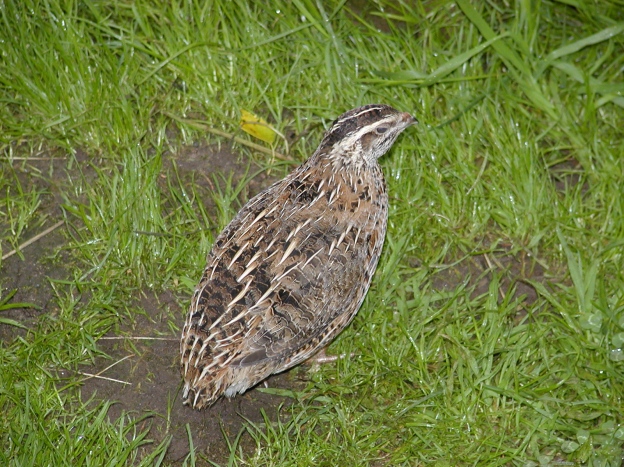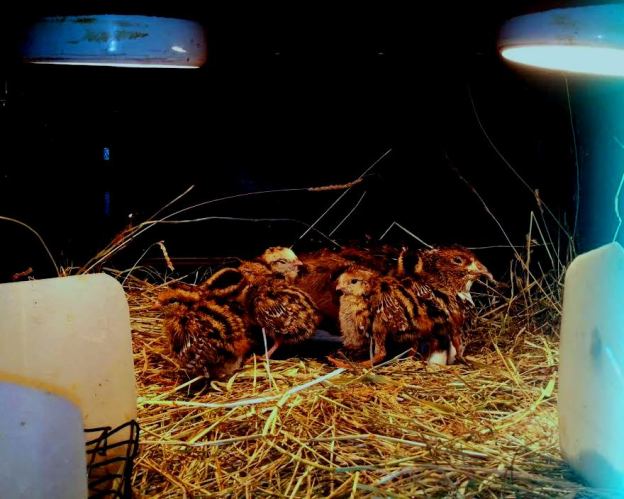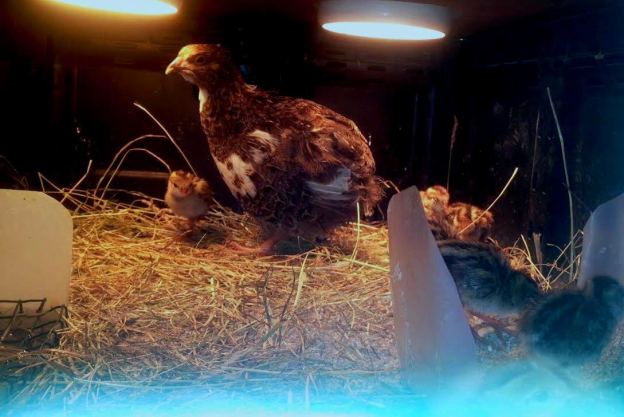
HOW DO I LOOK AFTER MY QUAILS



There are many quail and pheasant breeding farms in Italia which all breed for release as hunting is still very popular. It is almost impossible to visit these farms for quarantine reasons as well as keeping the secrets and knowledge within the family. I managed to visit a farm through a contact I had who had a friend that knew the second cousin of the neighboring farmer’s daughter to the quail farm I visited. Even with my good contacts, I still was not allowed inside the cages, but gained enough information. This farm breeds Coturnix coturnix as they still appear in Europe and North Africa in the wild. The birds are small and only weigh about 130 g at maturity. There is a general concern among breeders that some breeders may cross the natural occurring birds with domesticated birds which definitely result in a bird much less adapted to local conditions and also have poor survival capabilities when released. The crossbreeds are a bit heavier and a much inferior flier.
All the following figures are rough estimates, but I think very close to reality. This specific farm sells about 250,000 live quails a year at €1.50 each. For this he has 1,300 breeding hens and 450 males producing 1,000 viable good eggs per day. He has 6 incubators that takes 3,500 eggs each and fills two of these every week. At 14 days the eggs are transferred to a Hatcher where about 5,600 chicks hatch every week, of which 5,000 grow to eight weeks of age when they are sold for release.
The interesting thing is that his Incubators run at 80% humidity and the Hatcher’s at 90%, which I thought are way too high, but apparently it works that way as I witnessed these levels personally.
The other interesting fact is that the growing cages are sheds with only canvas sides with holes in so the quails can come and go and fly in the adjacent aviaries if they wish. The quails are in these semi open cages from day one. Gas heaters keep the temperature at about 37C at ground level for the first four weeks. There after the temperature is slowly reduced to day temperature over about one to two weeks, depending on outside temperatures, to harden them up. It gets very cold and it was – 12C on the day I was there and the quails seemed to be happy – my quails would have been dead after the first day. The growing houses are all the same size of 10 X 20 meters each, with two aviaries of 20 X 20 meters each attached to the sides of each house. Each house holds half of the 5,600 day old chicks.
I was glad to have visited this successful third generation family business which is at present operated by the grandson only as the grandfather is retired and the father attends to the rest of the farm.




Raising Californian Quail in captivity has never been, and never will be easy. Their nervous character and wild instincts make them very unsuitable to captivity. Unfortunately, because of their disappearance from the wild in New Zealand, they will have to be multiplied in caged conditions, should we want to preserve this pretty little bird. The cavalier attitude of New Zealanders regarding nature will probably prevail and our efforts for conservation would have limited success – I know I am going to get a lot of criticism because of this statement, but with New Zealand and Australia being the number one countries in the world causing species loss, my argument is more or less proven.
Survival rates of Californian Quail during their first few weeks seem to be abnormally low, and I have adopted a number of strategies and designs to try and overcome this problem – all with varying levels of success, but none solving the problem entirely.
My latest survival strategy however seems to have addressed many of the problems. Instead of sending my old Coturnix coturnix quail hens to the stock pot, I selected a number the calm and motherly ones as foster mothers for the Californians. I put the mothers into the brooders a few days before the Californian chicks hatch so they can get acquainted with the environment and the warm conditions. When the chicks hatch I place them straight into the brooder with their new mother. Her presence seems to have multiple positive effects on the chicks – i.e. she teaches them to eat and drink immediately, calms them down and also broods them. The end result is that the little chicks have shelved their desire to become Kamikaze Pilots every time I want to change food or water. Everybody seems calm and happy and mortality for the last four groups, at five weeks of age, each with their own foster mother, has been almost zero (lost one).
There are a number of younger groups at present, each with their foster mothers and they are very calm and doing well. I do notice that some foster mothers are better at the job than others and will continue selecting the better ones, even though their has been no difference in mortality rate between the groups.
Going back to nature can teach us a lot!!
As there are so many interesting discussions going on about quail housing, here is a closer look at the inside my quail house.
Units consist of 30 cages (six high and five wide) each being 600 X 600 mm, housing four females and a male or six females. All cages have a easy removable front feeder which gives easy access to individual cages, should it be required. Each cage also has a water drinker fed from a feeder tank. Some of the cages have a removable wire partitioning for gradual introduction of new birds. The units are inside a room with adequate cross ventilation but no direct drafts. No additional heating is supplied.
Clean home mixed feed is fed on a ad lib basis with easy access to feeders for regular supervision. Enough feeder space, easily accessible for the birds, is supplied to eliminate competition at the through
Clean fresh water through water cups is provided at all times
Floors are laminated ply wood and is removable, much easier on the birds than wire. The second photo shows how a clean floor board is slid under the used board, and the latter pulled out from the top. In the pictures the feeder has been removed for demonstration purposes only, but in practice the change of floors, which takes a few seconds, is done with the birds inside and feeders in the normal position – often the birds do not even notice that the floor is being changed. Now the dirty floors can be cleaned and be ready for the next change. I do mine about once every two weeks.
Each cage is fitted with a sand bath large enough for all the birds to be inside the bath at the same time if they so wish. Lighting is shielded, providing a soft glow that has a calming effect on the birds.
The unit accommodates up to 180 birds and takes up about 2 square meters of floor space, with enough space for the individual birds to relax and produce optimally. Birds are not kept on wire at any stage in time, as so many people do, as it is not beneficial to their health and well being. My birds are docile, calm, relaxed and happy and most of the time, when entering the room, with many hundreds of birds inside, there is not a sound as all the birds are calm, quiet and happy.
It is of the utmost importance for any living organism to have a good start in life. Because of the many questions relating to Quail rearing and feeding, I have decided to post a series on the subject, mostly reflecting my own point of view and experience over a long period of time, backed by scientific facts. The series will consist of three chapters, i.e. 1 – Hatch to Two weeks ; 2 – Two weeks to Five weeks and 3 – Five weeks to Eight weeks.
2 – TWO WEEKS TO FIVE WEEKS
The birds, at two weeks of age, are old enough to have resolved all the genetic, hatching and birth defects and mortality should almost be zero from this point onward. Keep the brooder at 38 C and make sure the bedding is dry and clean. If there were to be any spillage of water or dirt, remove the soiled bedding and top up with clean dry bedding at all times. Dont overcrowd them, keep them dry, warm,well fed and watered.
As they are growing at a phenomenal rate and are due to reach 90 – 95 % of their final body weight at five weeks of age, it is good to split the groups into two now. This will give every 10 birds about 0.25 meters square – enough to make them comfortable. Remember, we are trying to give our birds OPTIMUM conditions so as to allow them the opportunity to express their genetic ability to the maximum. Five week old birds are almost mature and it is a good time for selection on phenotype and measured production parameters to be able to eliminate sub standard birds early.
Remove and dispose immediately of any animal that has any defect, being it a hereditary defect or otherwise, or is in the bottom 30 % of measured production parameters.
The mass of the birds are increasing rapidly during this stage so always ensure that the birds have enough space and that the feeders and drinkers are positioned in such a way as to allow free movement and not cause dead traffic spots inside the brooder.
The time has also arrived to teach the young birds not to enter the feeding and drinking areas, which is exactly the opposite to what has been thought up to now. Any change in feeding and drinking routine should happen over a period of time. Leave the old feeders in place and introduce the new systems in parallel, then after two days, remove the old ones. This should minimise stress and assure continuous optimum performance. Allow 30 mm slots, at an appropriate height, for the birds to poke their heads through to eat or drink – this will also be small enough to not allow them to enter the feeders.
Feed should be a well formulated 28 % protein Quail Starter diet containing the correct ratio of amino acids and other macro elements, supplemented with the correct trace minerals and vitamins. Mix one chicken or four quail eggs (without shell) per 2 Kg of feed for the age groups two weeks to five weeks. Raw egg is beneficial if correctly and well mixed, alternatively mix in boiled eggs. Feed consistency must be fine and uniform bite sizes, but not dusty. If using a commercial diet, it is more often than not beneficial to supplement the diet with a trace mineral and vitamin pre-mix over and above what is supposedly already in the diet. It is virtually impossible to over dose with these nutrients, but deficiencies often occur effecting vitality, fecundity, mortality, disease resistance and production negatively. Trace mineral and vitamin deficiencies are very difficult to detect or measure under normal conditions, unless their is a severe shortage, but will always effect the animal negatively.
Lighting intensity is still the same as for the juveniles and still at 24 hours per day. allowing them maximum time to feed
Should you adhere to these few simple guidelines, you will not only have happy Quails, but also raise Quails successfully that will perform to their ability when mature